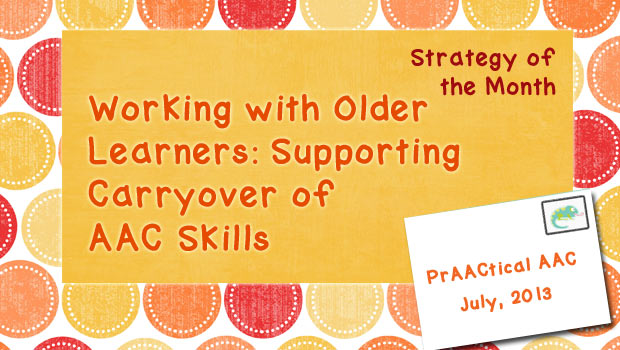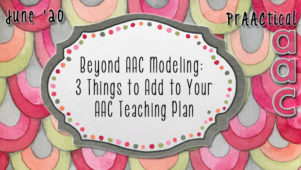Working with Older Learners: Supporting Carryover of AAC Skills

One of the biggest challenges that SLPs face is how to help the communicator use new skills outside the therapy room. Whether the client is someone who stutters, has voice problems, or any other speech-language difficulty, the question is the same: How can we get the client to use skills that were learned and practiced in a therapeutic situation to use those same skills at home, in school, and in the community? It’s an issue with all learners, but for adolescents and adults, we seem to be playing ‘catch up’ all the time. Plus, they are encountering greater numbers of less familiar communication partners and have to fend for themselves more often, making skill generalization even more of a critical topic.
Much has been written about problems of generalization by using loose training, and varying the instructional setting, partners, instructions, prompts, and materials. In our way of thinking, it starts with Goals that Matter. If we’re not working on things that will make a true difference in their daily life, the road to skill generalization will be a steep, uphill climb. Next, we try to have some semblance of a plan for generalization right at the beginning. From the moment we start teaching a new skill, we try to have a plan for helping the client to use it in a broader, more functional way. Starting to teach basic requesting? Get everyone on board to use communication temptations to elicit requests rather than just providing preferred items. Working on some new Tier 2 vocabulary or core words? Have your client use those with the office staff and peers. Expanding MLU? Elicit those longer utterance in every activity in the session.
Repetition with Variety
One of the easiest ways to get started on a path to skill generalization is to practice the behavior in a variety of activities. Eliciting a request for favored items can be broadened to requests for favorite music, videos, and people. We can plan to practice comments (e.g., “I like/don’t like it”) and questions (e.g., “What’s that?” “What’s next?”) in most of the therapy activities we do. In our vocabulary work, we can use new words in specifically designed tasks or games, functional activities, and general conversation. Once you adopt this mindset, it gets easier and easier to target a certain skill in every activity you do.
Try to use materials and activities that provide natural reinforcement as often as possible. If you teach someone size concepts (e.g., big/little) in terms of a favorite food, for example, the child quickly learns to ask for a ‘big’ portion in the therapeutic exchange, and, as a result, gets a larger serving. No artificial reinforcement is needed, plus the behavior will continue to get reinforced in real life even after the therapist has moved on to other skills.
Another way to add variety is to switch up the communication partners. In our university clinic, we often arrange for other students to pop into the therapy session for a few minutes so that the client has an opportunity to use the new skills with an unfamiliar partner. Good for the student clinicians who need as much experience as they can get, and great for the AAC learner. When planning your intervention, make sure to use lots of examples. Last week, we were teaching the concept of ‘some.’ As in ‘some’: games, books, doughnuts, friends, plates, backpacks, socks, chairs, cars, bottles of glue, pretzels, videos, and protein bars. If you teach a concept with lot of different examples of the learner is more likely to be able to understand and apply it to other situations..
Another tried-and-true method for building generalization is to practice in other places. Remember Shareka Bentham accompanying her students to the zoo? Loads of fun, of course, but the really awesome thing is that the kids gained experience using the AAC skills in a completely new environment.
Changing up the materials, activities, prompts, partners, and settings facilitates generalization by bringing the therapeutic experience closer to the real-world experiences that this learner is likely to have. Do you have strategies for helping older students or adults generalize their AAC skills? We’d love to hear about them.
Filed under: Strategy of the Month
Tagged With: generalization
This post was written by Carole Zangari




